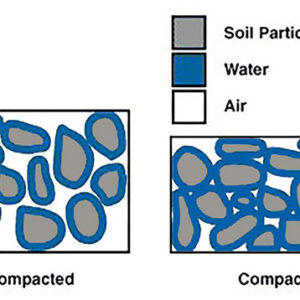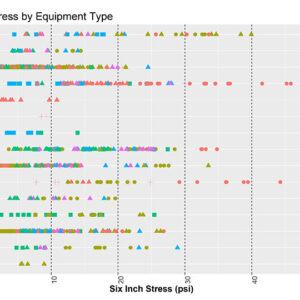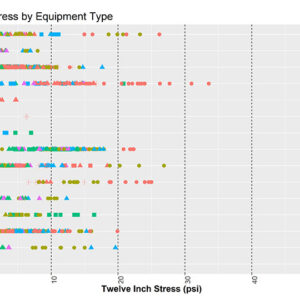
Features
Environment Research
Research
Top stories of 2023: The impact of compaction
Heavy equipment can cause soil compaction. How can manure applicators mitigate any damage?
December 19, 2023 by Bree Rody
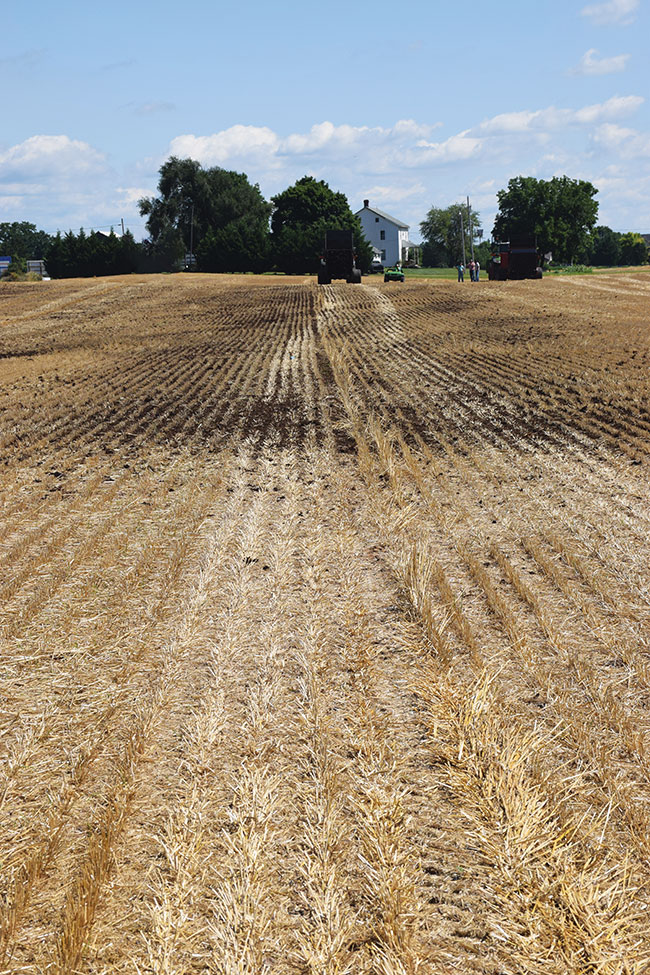 Multiple spreaders on the field at the North American Manure Expo in Chambersburg, PA in 2022.
Photo by Stefanie Croley
Multiple spreaders on the field at the North American Manure Expo in Chambersburg, PA in 2022.
Photo by Stefanie Croley On one hand, compaction in soil is essentially a black-and-white issue. At least, it’s black and white in the sense that few would argue that compaction is good. It’s not ideal for crop quality or yield, nor is it ideal for the overall health of a farm’s soil infrastructure. Healthy soils are soils with pores large enough to allow maximum water infiltration and has high water-holding capacity. When the number of moderate to large pores decreases in favor of smaller pores – the result of soil compaction – it can disrupt the movement of air, water, earthworms and other soil micro-organisms.
Alex Barrie, field specialist with the Ontario Ministry of Agriculture, Food and Rural Affairs (OMAFRA) says this is especially evident in tile-drained fields. “You go along fields that have been tile-drained, and it works really well, but then [the drainage] gets less and less productive,” he explains. “Part of that can just be that there’s more moisture. But part of it is [compaction] slowly wearing on the efficiency of that subsurface drainage, whether that’s subsurface compaction, or compaction.”
A dataset collected by Ohio State University’s Scott Shearer and extrapolated by the Ontario Soil Crop Improvement Association (OSCIA) in 2016 attempted to calculate the estimated cost of compaction for growers. OSCIA found the data demonstrated a six bu/acre (bushel-per-acre) yield difference from wheel traffic in soils with normal moisture, and a 27 bu/acre yield difference from wheel traffic in wet soils. At an estimated CAD $4.50/bu for corn, this would cost close to $50/acre with narrow width spread pattern manure application equipment.
What’s more, the size and weight of equipment has undoubtedly increased. Historical results from the Nebraska Tractor Test Laboratory program shows that tractor weights have increased by, on average, 900 lbs/year for tractors purchased on North American farms.
But, while there’s no grey area concerning the effects of compaction, there is a grey area when it comes to the question: what are growers to do?
For most medium- to large-sized farming operations, heavy equipment moving across a field, whether installing drainage and irrigation systems, spreading pesticides, harvesting crops or spreading manure, is unavoidable. The size and weight of tractors and spreaders has increased in large part because demand for more efficient application is much higher. As commercial manure applicators aim to improve the health and quality of crops and the fields on which they are grown, knowing how to do so while mitigating damage from compaction makes for a tricky dance.
Inside Ontario’s ‘compaction days’
One of the things Barrie remembers most about the recent summertime field days known as “compaction days” was how much sweat went into the demonstrations. Literally.
They were long days, says Barrie, in which he and a team of local soil and crop directors gathered at various sits – Arthur, Dundas, Elgin and Perth – to run equipment demonstrations with equipment provided by local farmers and dealerships.
Equipment included heavy-duty pickup trucks, tractors, manure tankers, grain wagons and more. “We bring them in, we load them up as heavy as they’ll ever be in operation and weigh all those tires on all of those vehicles.”
During the running of said vehicles, Barrie and his team had a number of sensors throughout the field. The vehicles were run across dryer and wetter pits in order to test the stress on soil in different conditions. The data points were plotted in real-time thanks to those sensors, resulting in readings for all types of ag equipment and enabling the field technician to plot their stress (PSI) at both six and 12 inches of soil. More than 540 individual readings were produced at the field days.
In some ways, says Barrie, the results weren’t necessarily telling him anything surprising. At a high level, he says, most farmers know that more weight and more pressure cause more compaction. The demo day, however, gives technicians such as Barrie valuable, tangible data that allows for more specific comparisons. And for farmers and for-hire applicators, it helps them understand the impact at the equipment level.
“What farmers want to see are those specific tires. They don’t really approach it from an engineering perspective. They get to see the different configurations and see the effects on the soil.”
While most agriculture professionals are most familiar with their own equipment and the specific scenarios in which they operate, Barrie says the demonstration day made room for “those hypotheticals.” For example, he said for applicators who always have their tires inflated for road pressure, the crew had the ability to lower the pressure on the go and demonstrate the benefits.
“We’ll do a high-pressure run and a low-pressure run [of the vehicles] and it’s actually quite shocking. [The audience] will say, ‘wow, that really made a big difference.’”
He said some were also shocked to see that a loaded Ford F150 pickup truck had “just about the same” amount of pressure as a manure spreader in terms of surface stress.
The manure factor
General results from five different probe locations at the Dundas site found that higher-parameter tires caused more soil pressure at the six-inch level.
Manure spreaders, says Barrie, are among the less impactful vehicles for soil pressure. All manure spreaders use radial tires, and tire loads were as low as just over 5,000 lbs and never higher than 20,000 lbs. Tire pressure from these vehicles were generally low-to-medium-low.
The pickup trucks observed were all well under 5,000 lbs for tire load, but had higher tire pressure, with most observed trucks at medium-to-high levels. Tractors, meanwhile, had a much bigger range of weights; at their lowest, tractors’ tire loads were as low as some pickup trucks, but at their highest, they were as heavy as a heavy manure spreader. Tractors with radial and bias tires tended to post lower tire pressure than those with tracks.
By comparison, grain buggies and combines had a much bigger variance in weight and, at their heaviest loads, were much higher (with the heaviest grain buggies higher than 45,000 lbs and the heaviest combines at around 35,000).
For soil stress, manure spreaders resulted in a moderate amount of stress at both six- and 12-inch depths. The highest-recorded amount of stress from a manure spreader at six inches was just under 35 PSI at the first probe location at the Arthur site. That same probe location saw higher stress at six inches from wagons, sprayers and forage wagons. The lowest stress recorded at six inches from a manure spreader was at the second probe location at the Arthur site, at under five PSI.
At 12 inches, manure spreaders topped out at around 23 PSI, once again at the first probe location at the Arthur site. Wagons, sprayers and forage wagons were once again the most impactful at this site. Most manure spreaders’ pressure was recorded at between five and 18 PSI. Results were also recorded at 20 inches, however most equipment posted lower pressure at 20 inches, with none over 15 PSI save for one wagon recording (second location, Arthur site) and one grain buggy reading (second location, Arthur site).
Barrie notes some limitations in the specific data, because the different sites have different conditions. “The strain rate on the soil is so different from site to site,” he says. “I can’t compare Arthur two years ago to Dundas last year.” He says for this reason, not only must for-hire manure applicators be prepared for anything, but landowners also have a certain responsibility when spreading manure or hiring someone to do so. “What they need to do is try to figure out how strong their soil is in any given sense of conditions, so I can say, ‘well, you can get your tire pressure to a certain limit.’”
Nevertheless, he was able to come out with some central takeaways. He says the forage equipment can be “sneaky” in terms of their pressure. Manure tankers, meanwhile, “have the benefit of being empty a lot of the time, whereas a piece of forage equipment is the same weight all of the time.”
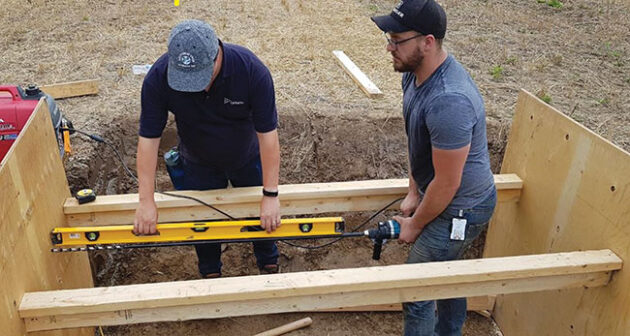
Alex Barrie, right, sets up one of the various sensors for an OMAFRA compaction demonstration.
Image courtesy of Alex Barrie/OMAFRA.
What’s an applicator to do?
While manure tankers are not among the worst culprits for pressure on soil, Barrie says there are always ways to ensure minimum impact for maximum production. He says it comes down to thinking critically when it comes to purchasing decisions, especially with tires.
“If you’re at a point in time where you need to replace tires on your equipment – and you should already be on radials – consider going to an IF or VF tire,” he says. “They’ll get you lower pressure for the same weight, and IF will get you [even] lower pressure.” He says the industry now favors IF tires, and thus most technology will skew toward IF tires. Either say, says Barrie, spending the money on a better tire is worth it.
Money spent on upgrades is often made back in efficiency, he notes. He says custom operators’ payback is “probably higher” when they use central tire inflation. “You get the benefit of high pressure on the road and low pressure on the field, which saves you a whole whack of fuel. You’re better set up to save fuel in both cases, and the payback is on both fuel savings and tire wear, rather than just the yield benefit from not compacting your soil” •
